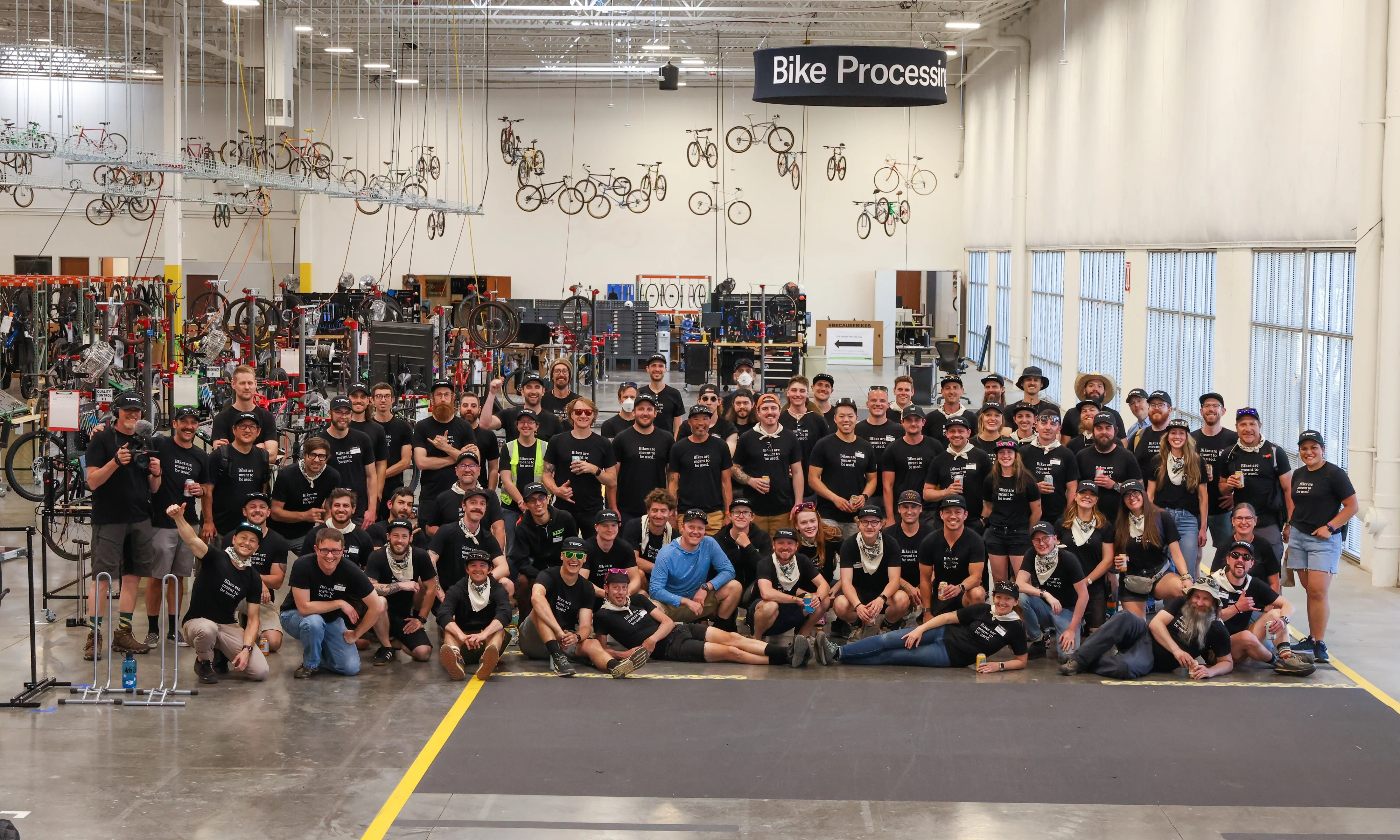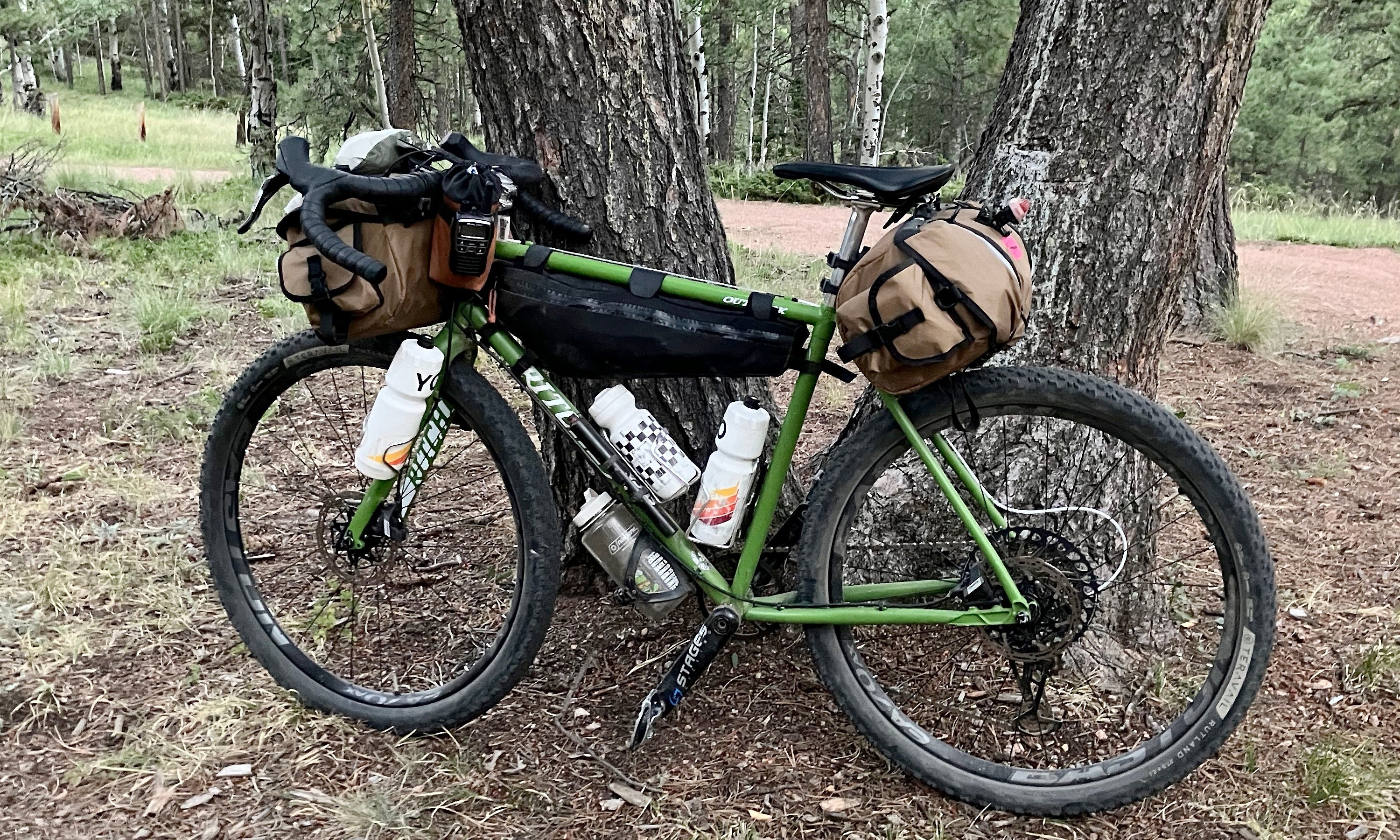Even for the most experienced riders, there’s always room to improve your cornering and descending. I’m going to cover a few basic tips that new and experienced riders can all use to safely and quickly conquer corners and descents on a gravel bike.
Pretty much all of these techniques come from mountain biking. If you’ve come to gravel from the road, or just neglected to practice these skills, then dedicating some time to mastering these techniques will pay dividends when things get loose and hairy.
Let’s start with our 6 top cornering and descending tips:
- Look where you want to go
- Keep your chest low
- Relax your hands
- Lean the bike under you
- Drop your outside foot
- Do most of your braking before turns
I’ll break each of these tips down a bit more below.
Tip 1: Look Where You Want to Go

If you don't turn your head and look, you're going to blow this turn.
Don’t stare at the ground right in front of your front wheel. When you enter a corner, lift your head and look ahead into the corner, either toward the exit or toward the entry of the following corner.
Your bike wants to go where you're looking, so if you focus intently on an object, like a rock, a rut, or the edge of the road, you’ll get target fixation and ride right into it. Instead, if you turn your head and look into the corner, it will naturally set you up to safely complete the corner.
There’s another big benefit to looking ahead. It makes it feel like you’re moving slower. The farther you can look ahead, the slower it will feel like you’re going. This increases the amount of data from the road you can process and reduces fear.
There’s another aspect to looking ahead that I learned from renowned mountain bike coach Lee McCormack — “hard” vs. “soft” focus. Hard focus is staring. It’s staring at particular features or dangers on the road. Rember target fixation? Hard focus leads to target fixation. Instead of hard focus, try to practice “soft” focus. Try to relax your vision. Don't look at anything in particular — but try to see everything.
If you’re worried about something on the ground in front of you — a rock, rut, or other obstacle — try to keep tabs on it using your peripheral vision. If your caveman brain freaks out and tells you to look at it, you can look at it quickly, but lift your eyes back up and get back to looking ahead as fast as you can.
Tip 2: Keep Your Chest Low

When riders get nervous, they tend to push their head and chest away from danger. When they do this, they end up sitting too upright or far back on their bike, which compromises control.
Instead, your chest should be in a low and aggressive position. This increases your range of motion and makes it easier to react to the terrain changing beneath new. It also keeps your weight forward over the front tire, which improves traction and reduces the chance of the front tire washing out.
To get your chest low, don’t just round your back and hold your weight up with your arms. The key is to hinge at your hips, fold your torso so it’s level, and bend your arms. This is true whether you’re standing or sitting in the saddle. If you can hinge at the hips, your weight will be supported more by your core, hamstrings, and glutes, rather than resting entirely on your hands. This is related to the next point.
Tip 3: Relax Your Hands

Try not to deathgrip your handlebars.
Overgripping wastes precious energy and beats you up. It also increases tension throughout the rest of your body, which decreases control. To corner and descend well, you need to find flow, and tension is the enemy of flow. Try to consciously relax your hands and grip your bars lightly.
If you’re a mountain biker, you may have heard the mantra: “Light hands, heavy feet.” Try to keep your hands relatively weightless and consciously keep more weight on your feet instead. You can always weight your feet, even when sitting in the saddle (see tip 5 below). Adopting this mantra keeps you loose and centers your weight between your wheels. This keeps you safer and in control.
Tip 4: Lean the Bike Under You

A great example of Mathieu van der Poel exaggerating the bike lean to charge through a tough off-camber corner.
When cornering on the road, leaning the bike in line with your body is often the best way to maximize traction in corners. On loose or sketchy off-road terrain though, it’s better to try to lean the bike a bit more than your body, or in other words, to try and lean the bike under you. This forces the cornering knobs on the edge of your gravel tire to bite into the ground, increasing traction (BTW, do this if you’re riding slick tires too).
This is an important skill in mountain biking, and it can be applied to gravel bikes too, especially when the terrain gets loose and sketchy. Being able to disconnect the lean angle of your bike from the lean angle of your body is one of the keys to safely and comfortably navigating technical terrain. It’s also a safer way to corner because it keeps your upper body loose and in a position that can react to changes in terrain more effectively. This increases the odds that you can save a slide.
Tip 5: Drop Your Outside Foot

When you're trying to survive a loose or sketchy turn, put all of your weight on your outside pedal. If you’re a skier, it feels a lot like weighting your outside ski.
Cornering with your outside foot down lowers your center of gravity and helps you lean the bike under you. It also helps weight the edge of your tire to increase traction. Dropping the outside foot also makes it easier to pull out your inside foot to dab in a corner and save a slide if needed.
Tip 6: Do Most of Your Braking BEFORE Turns

If you slam on the brakes in the middle of a loose turn like this, you're gonna have a bad time.
Your tires only have so much traction to give. When you’re leaned over and cornering, there’s less available grip for braking. Ideally, you get most or all of your braking done before you enter a turn, while the bike is still upright and you’re still going in a straight line.
If you’re building your cornering confidence, slow down until there’s no apprehension, then release the brakes and turn in. If you do this, then more tire traction can be dedicated to cornering and you won’t have to panic brake in the middle of the corner to scrub speed, which is a great way to slide out and crash.
If you do need to brake in a corner, try to use your rear brake more than your front brake, and do it gently. Breaking traction in the rear is often safer and easier to recover than breaking traction in the front.
Bonus Tip: Try to Brake LESS
We want to do most of our braking before corners, but another great thing to practice is trying to brake as little as possible. Fast descenders are generally fast because they brake less. When they do brake, they brake later and harder. This confidence comes from experience. If you’re always riding your brakes down the whole descent, it’s hard to build the confidence to let go.
Practicing braking less is something you can start doing on fast and straight descents. Let go of the brakes more and more until you get to the point where you can let go of the brakes the whole way down. Then you can build up to braking later and harder before corners.
How to Practice Cornering and Descending
Sessioning
The best thing you can do is find a gravel corner somewhere, ideally a downhill one, and just session it by riding it over and over again. Focus on executing the skills described in these six tips, and slowly build your speed and confidence. To keep things simple, it might be best to focus on one tip/skill at a time.
This is a great activity to do on an easy day or recovery day. Or, if you have a hankering for hill repeats, you can find a hill with corners that you can ride up and down multiple times. Get your workout on the uphills, and focus on skills on the downhills.
Parking Lot Drills

If you want something easy, you can also try some simple parking lot drills. Setting up a few cones or other objects to do slaloms and low-speed U-turns or figure-8s can help you practice skills like looking ahead, hinging at your hips to lower your chest, relaxing your hands, leaning the bike under you, and turning without using brakes. Because the speeds are low, the consequences are low too.
Ride Tougher Terrain

If you have the option, my favorite way to get confident handling your gravel bike is by riding singletrack trails or gravel roads that are extra loose, rough, or rocky. You’ll need to use all of the handling skills covered here to navigate technical terrain, and it’s just a lot of fun.
This also teaches you another essential skill: relaxing when you’re getting beat up. Many tougher gravel races — like Unbound Gravel — feature a lot of rough and technical terrain. If you aren't relaxed and tense up when things get rough, or you haven’t built up any “durability” in your body, then you’ll feel shattered by the end. Regularly exploring rough terrain will teach you to relax, which is essential to finding flow and handling your bike, and toughen you up.

























